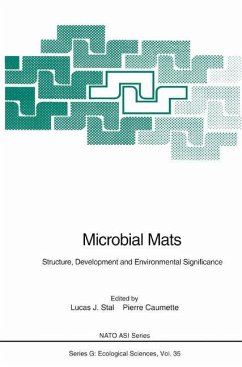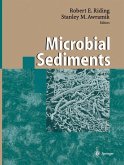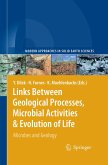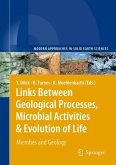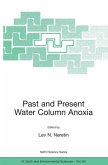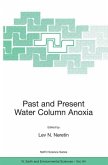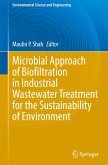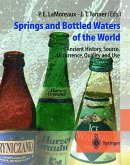Microbial Mats
Structure, Development and Environmental Significance
Herausgegeben von Stal, Lucas J.; Caumette, Pierre
Microbial Mats
Structure, Development and Environmental Significance
Herausgegeben von Stal, Lucas J.; Caumette, Pierre
- Broschiertes Buch
- Merkliste
- Auf die Merkliste
- Bewerten Bewerten
- Teilen
- Produkt teilen
- Produkterinnerung
- Produkterinnerung
Microbial mats are benthic communities of a variety of microorganisms. Their investigation requires multidisciplinary studies and close cooperation between microbiologists, biogeochemists, and geologists. Reported here are recent advances in the study of structure, development and ecological relationships. The methodology described includes microsensors as well as new molecular techniques for the detection and identification of microorganisms. Increasing interest exists for applied aspects, e.g. the possibility to use natural or constructed microbial mats for the degradation of xenobiotics, for site remediation, etc.…mehr
Andere Kunden interessierten sich auch für
![Microbial Sediments Microbial Sediments]() Microbial Sediments223,99 €
Microbial Sediments223,99 €![Links Between Geological Processes, Microbial Activities & Evolution of Life Links Between Geological Processes, Microbial Activities & Evolution of Life]() Links Between Geological Processes, Microbial Activities & Evolution of Life112,99 €
Links Between Geological Processes, Microbial Activities & Evolution of Life112,99 €![Links Between Geological Processes, Microbial Activities & Evolution of Life Links Between Geological Processes, Microbial Activities & Evolution of Life]() Links Between Geological Processes, Microbial Activities & Evolution of Life112,99 €
Links Between Geological Processes, Microbial Activities & Evolution of Life112,99 €![Past and Present Water Column Anoxia Past and Present Water Column Anoxia]() Lev N. Neretin (ed.)Past and Present Water Column Anoxia229,99 €
Lev N. Neretin (ed.)Past and Present Water Column Anoxia229,99 €![Past and Present Water Column Anoxia Past and Present Water Column Anoxia]() Lev N. Neretin (ed.)Past and Present Water Column Anoxia229,99 €
Lev N. Neretin (ed.)Past and Present Water Column Anoxia229,99 €![Microbial Approach of Biofiltration in Industrial Wastewater Treatment for the Sustainability of Environment Microbial Approach of Biofiltration in Industrial Wastewater Treatment for the Sustainability of Environment]() Microbial Approach of Biofiltration in Industrial Wastewater Treatment for the Sustainability of Environment123,99 €
Microbial Approach of Biofiltration in Industrial Wastewater Treatment for the Sustainability of Environment123,99 €![Springs and Bottled Waters of the World Springs and Bottled Waters of the World]() Philip E. LaMoreaux / Judy T. Tanner (eds.)Springs and Bottled Waters of the World77,99 €
Philip E. LaMoreaux / Judy T. Tanner (eds.)Springs and Bottled Waters of the World77,99 €-
-
-
Microbial mats are benthic communities of a variety of microorganisms. Their investigation requires multidisciplinary studies and close cooperation between microbiologists, biogeochemists, and geologists.
Reported here are recent advances in the study of structure, development and ecological relationships. The methodology described includes microsensors as well as new molecular techniques for the detection and identification of microorganisms. Increasing interest exists for applied aspects, e.g. the possibility to use natural or constructed microbial mats for the degradation of xenobiotics, for site remediation, etc.
Reported here are recent advances in the study of structure, development and ecological relationships. The methodology described includes microsensors as well as new molecular techniques for the detection and identification of microorganisms. Increasing interest exists for applied aspects, e.g. the possibility to use natural or constructed microbial mats for the degradation of xenobiotics, for site remediation, etc.
Produktdetails
- Produktdetails
- NATO ASI Series G: Ecological Sciences .35
- Verlag: Springer, Berlin
- Softcover reprint of the original 1st ed. 1994
- Seitenzahl: 488
- Erscheinungstermin: 13. Dezember 2011
- Englisch
- Abmessung: 235mm x 155mm x 27mm
- Gewicht: 733g
- ISBN-13: 9783642789939
- ISBN-10: 3642789935
- Artikelnr.: 36117146
- Herstellerkennzeichnung
- Springer-Verlag GmbH
- Tiergartenstr. 17
- 69121 Heidelberg
- ProductSafety@springernature.com
- NATO ASI Series G: Ecological Sciences .35
- Verlag: Springer, Berlin
- Softcover reprint of the original 1st ed. 1994
- Seitenzahl: 488
- Erscheinungstermin: 13. Dezember 2011
- Englisch
- Abmessung: 235mm x 155mm x 27mm
- Gewicht: 733g
- ISBN-13: 9783642789939
- ISBN-10: 3642789935
- Artikelnr.: 36117146
- Herstellerkennzeichnung
- Springer-Verlag GmbH
- Tiergartenstr. 17
- 69121 Heidelberg
- ProductSafety@springernature.com
Opening lecture.- Microbial mat research: The recent past and new perspectives.- I. Colonization and initial processes in mat formation.- Microbial mats in coastal environments.- Species diversity in hot spring microbial mats as revealed by both molecular and enrichment culture approaches - relationship between biodiversity and community structure.- Microbial mats in a thermomineral sulfurous cave.- Establishment of phototrophic purple sulphur bacteria in microbial mat systems.- Biological versus inorganic processes in stromatolite morphogenesis: observations from mineralizing sedimentary systems.- Morphological and chemical transformations of Microcoleus chthonoplastes during early diagenesis in hypersaline microbial mats.- On the significance of solar ultraviolet radiation for the ecology of microbial mats.- Environmental factors controlling the development of microbial mats in inland saline lakes; the granulometric composition of the sediment.- Structure of the sediment at depositional saline environments.- Microbial mediation of sediment structure and behaviour.- Field and cultivated Microcoleus chthonoplastes: The search for clues to its prevalence in marine microbial mats.- The sensitivity for salinity increase in the drought resistant cyanobacterium Crinalium epipsammum SAB 22.89.- Osmotic adaptation of microbial communities in hypersaline microbial mats.- Panel discussion: Colonisation and early development of microbial mat communities.- II. New methods in microbial mat research.- Analysis of microbial mats by use of electrochemical microsensors: Recent advances.- Optical properties of microbial mats: Light measurements with fiber-optic microprobes.- Gas diffusion probe for measurement of CH4 gradients.- Light and electron microscopy in microbial mat research:An overview.- Motility of Microcoleus chthonoplastes subjected to different light intensities quantified by digital image analysis.- Application of molecular genetics to the study of microbial communities.- Determination of the genetic diversity of microbial communities using DGGE analysis of PCR amplified 16 S rDNA.- Exopolymers in microbial mats: Assessing their adaptive roles.- The challenge to analyse extracellular polymers in biofilms.- New cultivation techniques and laboratory model systems for investigating the growth of stratified microbial communities.- Panel discussion: New methods in microbial mat research.- III. Microscale interactions in microbial mats.- Diffusion processes and boundary layers in microbial mats.- Cycling of carbon, sulfur, oxygen and nutrients in a microbial mat.- Nitrogen cycling in microbial mat communities: the quantitative importance of N-fixation and other sources of N for primary productivity.- Anaerobic dark energy generation in the mat-building cyanobacterium Microcoleus chthonoplastes.- Production and consumption of volatile organosulfur compounds in microbial mats.- Panel discussion: Mcroscale interactions in microbial mats.- IV. Diel and spatial variations of physico-chemical parameters and processes in microbial mats.- The carbon isotope biogeochemistry of microbial mats.- The fluxes of inorganic carbon and CO2-dependent genes involved in the cyanobacterial inorganic carbon-concentrating mechanism: A view on some of the open questions.- Oxygenic photosynthesis and light distribution in marine microbial mats.- The effects of irradiance, temperature and desiccation on cyanobacterial photosynthesis: A possible explanation for the diurnal changes in surface waterblooms.- Denitrification, nitrification and nitrogen assimilation in photosynthetic microbial mats.- Nitrogen fixation dynamics in microbial mats.- Relationships between functional groups of organisms in microbial mats.- Diel and spatial fluctuations of sulfur transformations.- Panel discussion: Diel and spatial variations of physico-chemical parameters and processes in microbial mats.- V. New physiological groups of organisms in microbial mats.- Novel metabolic capacities of sulfate-reducing bacteria, and their activities in microbial mats.- Diversity of and interactions among sulphur bacteria in microbial mats.- Phototrophic oxidation of ferrous minerals - a new aspect in the redox microbiology of iron.- Heterocystous versus non-heterocystous cyanobacteria in microbial mats.- Development of versicolored microbial mats: succession of microbial communities.- Light-driven sulfate reduction and methane emission in hypersaline cyanobacterial mats.- Panel discussion: New physiological groups of bacteria.- VI. Bioremediability and biogeochemical cycles (panel discussion).- Bioremediability and biological value of microbial mats.- New concepts in biogeochemical cycling and ecology.- General considerations.- Cyanobacterial mats in general biology.
Opening lecture.- Microbial mat research: The recent past and new perspectives.- I. Colonization and initial processes in mat formation.- Microbial mats in coastal environments.- Species diversity in hot spring microbial mats as revealed by both molecular and enrichment culture approaches - relationship between biodiversity and community structure.- Microbial mats in a thermomineral sulfurous cave.- Establishment of phototrophic purple sulphur bacteria in microbial mat systems.- Biological versus inorganic processes in stromatolite morphogenesis: observations from mineralizing sedimentary systems.- Morphological and chemical transformations of Microcoleus chthonoplastes during early diagenesis in hypersaline microbial mats.- On the significance of solar ultraviolet radiation for the ecology of microbial mats.- Environmental factors controlling the development of microbial mats in inland saline lakes; the granulometric composition of the sediment.- Structure of the sediment at depositional saline environments.- Microbial mediation of sediment structure and behaviour.- Field and cultivated Microcoleus chthonoplastes: The search for clues to its prevalence in marine microbial mats.- The sensitivity for salinity increase in the drought resistant cyanobacterium Crinalium epipsammum SAB 22.89.- Osmotic adaptation of microbial communities in hypersaline microbial mats.- Panel discussion: Colonisation and early development of microbial mat communities.- II. New methods in microbial mat research.- Analysis of microbial mats by use of electrochemical microsensors: Recent advances.- Optical properties of microbial mats: Light measurements with fiber-optic microprobes.- Gas diffusion probe for measurement of CH4 gradients.- Light and electron microscopy in microbial mat research:An overview.- Motility of Microcoleus chthonoplastes subjected to different light intensities quantified by digital image analysis.- Application of molecular genetics to the study of microbial communities.- Determination of the genetic diversity of microbial communities using DGGE analysis of PCR amplified 16 S rDNA.- Exopolymers in microbial mats: Assessing their adaptive roles.- The challenge to analyse extracellular polymers in biofilms.- New cultivation techniques and laboratory model systems for investigating the growth of stratified microbial communities.- Panel discussion: New methods in microbial mat research.- III. Microscale interactions in microbial mats.- Diffusion processes and boundary layers in microbial mats.- Cycling of carbon, sulfur, oxygen and nutrients in a microbial mat.- Nitrogen cycling in microbial mat communities: the quantitative importance of N-fixation and other sources of N for primary productivity.- Anaerobic dark energy generation in the mat-building cyanobacterium Microcoleus chthonoplastes.- Production and consumption of volatile organosulfur compounds in microbial mats.- Panel discussion: Mcroscale interactions in microbial mats.- IV. Diel and spatial variations of physico-chemical parameters and processes in microbial mats.- The carbon isotope biogeochemistry of microbial mats.- The fluxes of inorganic carbon and CO2-dependent genes involved in the cyanobacterial inorganic carbon-concentrating mechanism: A view on some of the open questions.- Oxygenic photosynthesis and light distribution in marine microbial mats.- The effects of irradiance, temperature and desiccation on cyanobacterial photosynthesis: A possible explanation for the diurnal changes in surface waterblooms.- Denitrification, nitrification and nitrogen assimilation in photosynthetic microbial mats.- Nitrogen fixation dynamics in microbial mats.- Relationships between functional groups of organisms in microbial mats.- Diel and spatial fluctuations of sulfur transformations.- Panel discussion: Diel and spatial variations of physico-chemical parameters and processes in microbial mats.- V. New physiological groups of organisms in microbial mats.- Novel metabolic capacities of sulfate-reducing bacteria, and their activities in microbial mats.- Diversity of and interactions among sulphur bacteria in microbial mats.- Phototrophic oxidation of ferrous minerals - a new aspect in the redox microbiology of iron.- Heterocystous versus non-heterocystous cyanobacteria in microbial mats.- Development of versicolored microbial mats: succession of microbial communities.- Light-driven sulfate reduction and methane emission in hypersaline cyanobacterial mats.- Panel discussion: New physiological groups of bacteria.- VI. Bioremediability and biogeochemical cycles (panel discussion).- Bioremediability and biological value of microbial mats.- New concepts in biogeochemical cycling and ecology.- General considerations.- Cyanobacterial mats in general biology.

